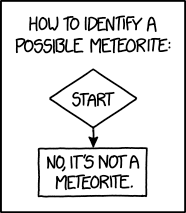Meteorite Identification

Click for an actual flowchart for identifying a meteorite. My favorite part is how 'Did someone see it fall? -> Yes' points to 'NOT A METEORITE.' This is not a mistake.

Click for an actual flowchart for identifying a meteorite. My favorite part is how 'Did someone see it fall? -> Yes' points to 'NOT A METEORITE.' This is not a mistake.
Meteorites form when a meteoroid survives entrance through the Earth's atmosphere as a meteor. Thus, they are very rare rocks that come from space, and can stem from broken asteroids, the Moon, and sometimes (very rarely) even from Mars.
The flowchart, though facetious, would actually work the vast majority of the time a person picks up a rock and believes it to be a meteorite, since any single rock one finds on the surface of the earth is almost definitely not a meteorite.
Flowcharts are often used (in xkcd) to give the inexperienced a step-by-step process to follow (see a guide to flowcharts here: 518: Flow Charts). Meteorite identification, however, is very difficult, so the brevity of this flowchart in a way pokes fun at the need for a flowchart to identify meteorites, since laypeople are not experienced enough to confirm that a rock is indeed a meteorite. A similar short flowchart as this has been used recently in 1691: Optimization, and another only two box chart was used in 1195: Flowchart.
In the title text Randall mentions that the comic image is a link to the more detailed (now defunct, mirror here) Meteorite or meteorwrong? Self-Test Check list flowchart at the Department of Earth and Planetary Sciences at Washington University in St. Louis.
The authors of those resources notes that they have received many rock samples and photos (or even personal visits) from people claiming to have discovered meteorites and thus they would likely benefit from just providing people the shortcut flowchart from Randall, as a way of saying, "leave meteorite identification to the professionals."
Randall also mentions in the title text that his favorite part of this real flowchart, which is the part where if anyone saw the "meteor" fall then it is 'NOT A METEORITE.' What he most likes about it is that this is not a mistake.
First of all the chance of actually being near a falling meteorite is exceedingly small. From the flowchart was a link to a 64 point long checklist, which basically all ends in "..., then it's not a meteorite." In point 3 is noted the following:
- Since 1900, the numbers of recognized meteorite "falls" is about 690 for the whole Earth. That's 6.3 per year. Only 98 of those occurred in the US. That's less than 1 per year. Even when a meteorite is observed to fall, experienced meteorite hunters may find only a few stones when hunting dawn to dusk for a week.
Second, meteors that can be seen falling almost definitely cannot be found on the ground immediately after. Any meteor big enough to glow and be visible while falling all the way to the ground will leave a large impact crater, rather than simply sit on the ground as a rock. Smaller meteors do not fall fast enough to glow all the way to the ground. Either they will burn up completely (not leaving any meteorite) or they will be slowed down before they burn all the way up (but typically end up much smaller than the original meteoroid). After that they will stop glowing and will brake even further until they reach a terminal velocity due to air resistance. Their small size, and lack of glow, make them practically impossible to follow with the naked eye even in daylight. If a person stands close by the impact location of a meteor it may be possible to hear a swish and a thunk, from when it passes by and then hit the ground. It will then be possible to locate the meteorite, but such a falling stone could also have been dropped from an airplane or by a storm. But in some few cases people have actually heard a real meteor falling and found it afterwards. This is what happened with the 690 events mentioned above. All this is described on How to Identify a Meteorite from The Meteorite Market which is linked in point 48 in the table from Washington University. But they did not see it fall!
What Randall finds so funny about this part of the flowchart is that there are three arrows leading to the question "Did someone see it fall?", but from there only a "Yes" option is possible, and then this gives the result "Not a meteorite." This indicates that if you have found a rock that has no dark crust or regmaglypts (the options that by saying no takes the user to the question about seeing it fall), then it is not a meteorite, and then the only reason people might still believe it to be a meteorite must be because someone saw it fall and assumed it came from space (rather than more likely scenarios, such as a stone coming loose from a cliff or building, or being dropped by a bird or aircraft).
If the rock actually has those thumbprint like impressions on the surface (that scientists call regmaglypts) then the creator of the flowchart actually asks to see the rock (photo or sample). The other features that are interesting is if it has a dark thin crust (from the melting during entry), but only if it also has either regmaglypts or if it has a lighter color inside than the outer crust.
See also 1405: Meteor about how people mistake the words meteorite with meteor. The many misspellings of meteorite is mentioned in point 63 in the table.